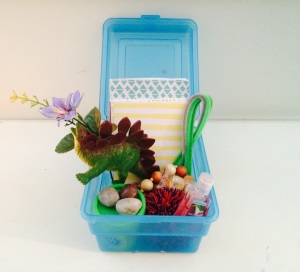Many children struggle to recover from high-emotion situations. Tantrums become drawn out and exhausting for both the child and caregiver. Items found in a Calming Box can provide visual and hands-on activities to help soothe a child’s mind and body. The child or parent notices the child is getting agitated or upset and retrieves the box. Either together with the parent, or alone, the child can use what is inside to relax and reach a calm state. The box should be kept somewhere easily accessible to the child, in a quiet area.
Creating a Calming Box can be a bonding experience between caregiver and child. Tailor the ingredients of your child’s box to their specific needs, keeping in mind their natural temperament and strengths. For example, if you notice your child tends to be very calm when drawing or coloring creatively, be sure to include plenty of creative items like paper, utensils, stickers, stencils, etc. The ultimate goal is that the child learns how to create coping mechanisms to reach a calm state on their own. It is important to note that time using a calming box should not be treated as punishment or a “time-out,” but rather as an opportunity for the child to slow down to make a better choice.
When brainstorming, keep in mind the five senses – touch, taste, smell, sound, sight. What is visually pleasing to your child? What is a fun taste? What might be an interesting texture? Use this list to help you dream up the perfect box for your child.
- Scraps of textured fabric – velvet, felt, fake fur
- A cozy blanket
- Stress balls
- Colorful molding clay
- A mint or breath strip
- A piece of gum
- Hard candy with layers of flavor
- Scented candle
- Fake flowers with a calming scent
- Scratch and sniff stickers
- Pieces of paper to rip, shred, or crumple up
- Two pieces of sandpaper to rub together
- List of emotions
- Calming music tracks
- A journal or drawing pad
- A small bell
- Pictures of family, friends, or a pet
- Photos of fun, relaxing places – beach, a family member’s home
- Small mirror
- Sand timer
- Stencils
- Snow globe or similar item
- Pinwheel
- Rainstick
- Crayons, colored pencils, markers
For other creative calming techniques to use with your child at home, contact Christine Taylor, LPC at (847) 366-5621 x123.

